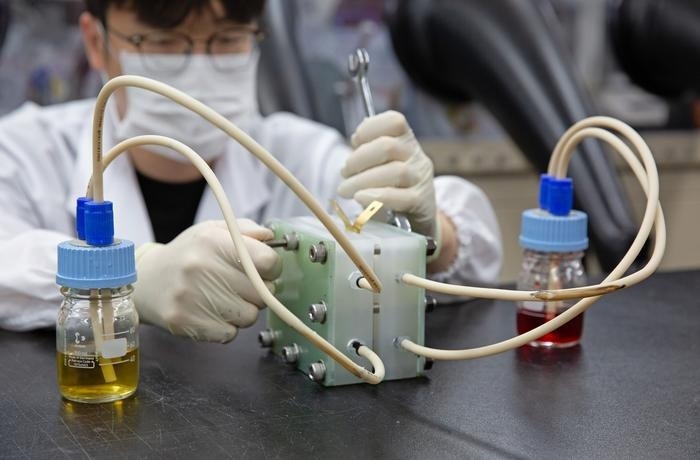A team of researchers at the Korea Institute of Energy Research's Energy Storage Research Department has successfully improved the performance and cycle life of redox flow batteries by substituting functional groups for active materials and enhancing stability and solubility. The technique has been developed to substitute a less expensive material for the active material in large-capacity electrochemical storage systems, or "redox flow batteries." The study has been published in ACS Applied Materials & Interfaces.
 A researcher is assembling an organic material-based flow battery-1. Image Credit: Korea Institute of Energy Research
A researcher is assembling an organic material-based flow battery-1. Image Credit: Korea Institute of Energy Research
Redox flow batteries are a well-known large-capacity energy storage device. Dr. Seunghae Hwang's research team was involved in the research.
To increase the use of renewable energies like solar and wind power, a long-term energy storage system that can retain electricity produced during favorable weather conditions for longer than eight hours and reuse it when needed is required. Redox flow batteries are being researched extensively worldwide because they are less likely to catch fire and have a longer cycle life than lithium-ion batteries, which are more widely used. Additionally, the Republic of Korea is concentrating on creating high-efficiency, low-cost technologies that will be widely used by 2030.
Vanadium is currently sold as the active ingredient in redox flow batteries, but due to its finite supply, research into substitutes has recently increased. Particularly noteworthy are organic compounds like viologens, which are composed of naturally occurring elements like carbon and oxygen. They have the potential to replace vanadium and are relatively inexpensive. Nevertheless, the drawbacks of viologens include their low solubility, which lowers the total energy density, and their instability during repeated charging and discharging, which calls for the creation of technologies to address these problems.
Researchers have given viologens functional groups to address these problems. By fitting into the viologens like building blocks, these functional groups improve their stability and solubility.
Researchers added ester and sulfonate functional groups, which are soluble in water, to make viologens more soluble. These two functional groups create attractive forces between molecules through interactions with water (electrolyte) molecules on the viologens' surface, which helps the viologens disperse in water.
Viologens are made up of two molecular layers and have a sandwich-like structure. These layers often merge together during charging, transforming into a structure incapable of storing energy. Researchers introduced alpha-methyl functional groups, which function as barriers, to address this. These functional groups twist the layered structure and cause repulsion between molecules, which reduces side reactions and improves the stability and efficiency of energy storage.
It was verified that the energy density increased by more than twice when the researchers' active material was applied to redox flow batteries as opposed to vanadium redox flow batteries. Furthermore, the batteries showed improved performance and stability with 92.4% capacity retention and 99.4% coulombic efficiency (discharge capacity relative to charge capacity) after 200 cycles of charging and discharging.
In response to climate change and to expand the use of renewable energy, it is necessary to facilitate energy storage through the development of redox flow batteries that have both price competitiveness and long cycle life. This research enables the design of active materials that achieve both affordability and longevity, contributing to the early commercialization of redox flow batteries.
Dr. Seunghae Hwang, Study First Author, Korea Institute of Energy Research
Journal Reference:
Hwang, S., et al. (2024) Integration of Functional Groups to Enhance the Solubility and Stability of Viologen in Aqueous Organic Redox Flow Batteries. ACS Applied Materials & Interfaces. doi.org/10.1021/acsami.4c04528